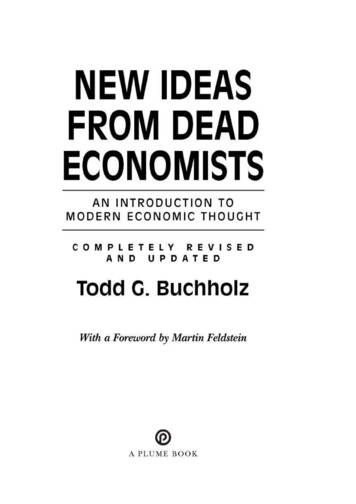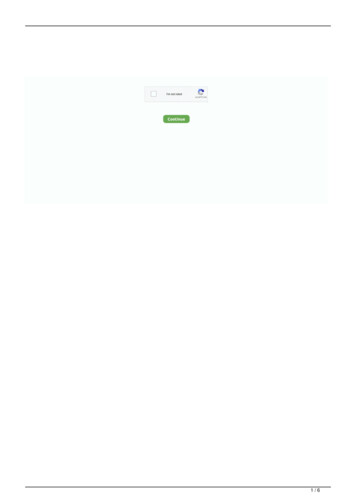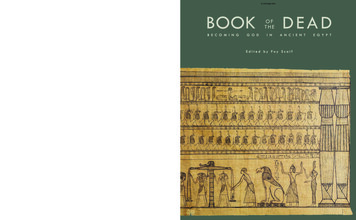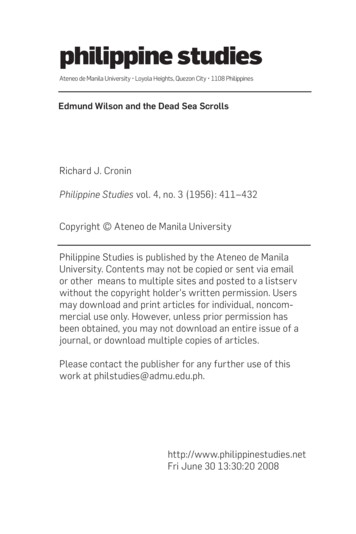
Transcription
Table of ContentsTitle PageCopyright PageForewordPreface to the Revised EditionAcknowledgementsCHAPTER I ‐ Introduction: The Plight of the EconomistCHAPTER II ‐ The Second Coming of Adam SmithCHAPTER III ‐ Malthus: Prophet of Doom and Population BoomCHAPTER IV ‐ David Ricardo and the Cry for Free TradeCHAPTER V ‐ The Stormy Mind of John Stuart MillCHAPTER VI ‐ The Angry Oracle Called Karl MarxCHAPTER VII ‐ Alfred Marshall and the Marginalist MindCHAPTER VIII ‐ Old and New InstitutionalistsCHAPTER IX ‐ Keynes: Bon Vivant as SaviorCHAPTER X ‐ Milton Friedman and the Monetarist Battle Against KeynesCHAPTER XI ‐ The Public Choice School: Politics as a BusinessCHAPTER XII ‐ The Wild World of Rational Expectations and Behavioral EconomicsCHAPTER XIII ‐ Dark Clouds, Silver LiningsNotesIndex2
A PLUME BOOKNEW IDEAS FROM DEAD ECONOMISTSTODD G. BUCHHOLZ is an internationally acclaimed economist who advises some of the world’sleading investment funds. He has served as a director of economic policy at the White House and asa managing director of the legendary Tiger hedge fund. Buchholz holds advanced degrees fromCambridge University and from Harvard, where he was awarded the Allyn Young Teaching Prize bythe Department of Economics. His other books include New Ideas from Dead CEOs, From Here toEconomy, Market Shock, Bringing the Jobs Home, and a novel, The Castro Gene. He lives in SolanaBeach, California.Praise for New Ideas from Dead Economists“If you only read one economics book this year, read this one.”—Lawrence H. Summers, former U.S. Treasury Secretary, Professor of Political Economy, HarvardUniversity“Readable . . . enjoyable . . . valuable to the lay reader who wishes to speak intelligently abouteconomics and world markets.”—National Review“A first‐class book.”—The Christian Science Monitor“Witty . . . accessible . . . a history of economic thought that won’t scare even the worsteconophobes.”—Phoenix Republic“A sorely needed and well‐written guide to the still living ideas that fashion our prosperity.”—AlfredL. Malabre, Jr., author of Understanding the New Economy“Lights up economics with a wickedly sparkling wit.”—Associated Press“An excellent review of contemporary macroeconomic theories and issues . . . It does not get anybetter than this.”—Choice“Effective and entertaining . . . highly recommended.”—Library Journal“Successfully puts a wide range of economic theories and philosophies into an understandable,everyday perspective.”—Booklist3
ALSO BY TODD G. BUCHHOLZNONFICTIONNew Ideas from Dead CEOsFrom Here to EconomyMarket ShockBringing the Jobs HomeFICTIONThe Castro Gene4
5
PLUMEPublished by the Penguin GroupPenguin Group (USA) Inc., 375 Hudson Street, New York, New York 10014, U.S.A. Penguin Group (Canada), 90Eglinton Avenue East, Suite 700, Toronto, Ontario, Canada M4P 2Y3 (a division of Pearson Penguin CanadaInc.) Penguin Books Ltd., 80 Strand, London WC2R 0RL, England Penguin Ireland, 25 St. Stephen’s Green,Dublin 2, Ireland (a division of Penguin Books Ltd.) Penguin Group (Australia), 250 Camberwell Road,Camberwell, Victoria 3124, Australia (a division of Pearson Australia Group Pty. Ltd.) Penguin Books India Pvt.Ltd., 11 Community Centre, Panchsheel Park, New Delhi ‐ 110 017, India Penguin Group (NZ), 67 Apollo Drive,Rosedale, North Shore 0745, Auckland, New Zealand (a division of Pearson New Zealand Ltd.) Penguin Books(South Africa) (Pty.) Ltd., 24 Sturdee Avenue, Rosebank, Johannesburt 2196, South AfricaCopyright Todd G. Buchholz, 1989, 1999, 2007Foreword copyright Martin Feldstein, 1989All rights reservedREGISTERED TRADEMARK—MARCA REGISTRADAThe Library of Congress has catalogued the New American Library edition as follows:Buchholz, Todd G.New ideas from dead economists / by Todd G. Buchholz:with a foreword by Martin Feldstein.p. cm.Includes bibliographical references.eISBN : 978‐1‐101‐04162‐81. Economists—Biography. 2. Economics—History. I. Title.HB76.B83 1989330’.092’2—dc2089‐12666Without limiting the rights under copyright reserved above, no part of this publication may be reproduced,stored in or introduced into a retrieval system, or transmitted, in any form, or by any means (electronic,mechanical, photocopying, recording, or otherwise), without the prior written permission of both thecopyright owner and the above publisher of this book.6
PUBLISHER’S NOTEThe scanning, uploading, and distribution of this book via the Internet or via any other means without thepermission of the publisher is illegal and punishable by law. Please purchase only authorized electroniceditions, and do not participate in or encourage electronic piracy of copyrighted materials. Your support of theauthor’s rights is appreciated.BOOKS ARE AVAILABLE AT QUANTITY DISCOUNTS WHEN USED TO PROMOTE PRODUCTS OR SERVICES. FORINFORMATION PLEASE WRITE TO PREMIUM MARKETING DIVISION, PENGUIN PUTNAM INC., 375 HUDSONSTREET, NEW YORK, NEW YORK 10014.http://us.penguingroup.com7
ForewordAll of us are affected by government economic policies and by private economic decisions.No one can be an informed voter or even an understanding reader of the daily newspaperwithout a knowledge of economics. And who can plan for the future in which we and ourchildren will live and work without a sense of the forces that shape our economic life?The economic policy issues that we debate today—trade policy, inflation, the proper roleof government, the eradication of poverty, and the means of raising the rate of economicgrowth—have been discussed by economists for more than two centuries. Many of today’seconomic policies—both the good ones and the bad—are the result of the ideas of thosepast economists. And many of today’s debates about economic policy can be understoodonly by those who have at least some familiarity with the ideas of earlier economists.The giants of economic science during the past two hundred years have been menconcerned with the critical policy issues of their time. They studied the working of theeconomy in order to advocate better economic policies. But despite their concern withpolicy, they were not polemicists or politicians but men who sought to persuade theircontemporaries in government and in the broader public by analysis and evidence thatwould meet the standards of professional debate.Like any scientific discipline, economics advances by discovering the limitations of earlierideas. Although economics does not have the opportunities for experimentation thatcharacterizes the natural sciences, economists can use systematic observation and theanalysis of experience to reject old theories and develop new ones.The changes in technology and in the political and institutional environment impede theprocess of drawing firm conclusions about the likely effects of alternative economic policies.It can take decades before issues are settled, and new generations of economists and policyofficials may have to learn that the conclusions of the past continue to be valid in thechanging environment of today.Adam Smith, the eighteenth‐century founder of modern economics, rejected theconventional wisdom of his day by arguing that government interference in the economy isgenerally harmful and that the public’s interest is best served by competition among privatebuyers and sellers. In recent years, governments around the world have recognized thevirtues of a market economy based on private enterprise rather than on governmentplanning and public ownership. The reduction of tax rates in the United States, theprivatization of nationalized industries in England and France, the resurrection of familyfarms in China, and the Soviet economic restructuring that has been labeled “perestroika”are the direct descendants of the early ideas of Adam Smith.The theories of John Maynard Keynes, developed in England during the depression of the1930s, have helped governments to avoid a return to mass unemployment. But the8
Keynesian arguments against saving and in favor of increased consumer spending are beinggradually abandoned as inappropriate for the very different conditions of today’s economy.Now we understand that increased saving can in general be the basis for increasedinvestment in new plant and equipment and therefore for faster economic growth and ahigher standard of living.When Federal Reserve officials make decisions about monetary policy and interest ratesthey are relying on ideas and evidence that can be traced back to nineteenth‐centuryeconomists like John Stuart Mill as well as on the latest data being developed inWashington. When Treasury officials debate appropriate tax rules for businesses andindividuals, they may make use of analytic arguments that date back more than a century toDavid Ricardo and Alfred Marshall. Similarly, the analysis of trade policy, energy andenvironmental regulation, and antitrust legislation are based on ideas that have developedthrough the centuries. A familiarity with these economic ideas is important for anyone whowants to understand how new policies are likely to affect the economy and why certainpolicies are chosen.In this book, Todd Buchholz provides a lively and intelligible introduction to the key ideasof economics through the study of the great economists who have shaped the discipline.Instead of the formal models and complex diagrams that are the focus of standardeconomics textbooks, Buchholz provides clear, nontechnical explanations and timelyexamples.I first met Todd Buchholz when he was teaching a section of the introductory economicscourse at Harvard. Buchholz was an excellent teacher who was selected from among thethirty other teachers in the course to receive the annual prize for outstanding teaching ofintroductory economics. His skills in the classroom are well displayed in this very readablebook.—Martin FeldsteinCambridge, Mass.June 19899
Preface to the Revised EditionVincent van Gogh painted twenty‐eight portraits of himself in just two years! I have avoidedsuch introspection and have managed to keep both ears attached to my head. I had notread New Ideas from Dead Economists since early 1989, when I delivered a manuscript tothe offices of E.P. Dutton, for its hardcover debut. I suppose some authors reread theirworks often, reminiscing about a skillful turn of phrase or prescient thought. Rather thanreread my work, I continually watched the world economy over the subsequent ten years tosee how the book’s ideas and the great economists’ ideas held up. This revised editionbenefits from a careful study of economic trends and crises from my perch as a White Houseeconomist, Wall Street adviser, investment fund manager—and father. I was none of thosewhen I drafted the first edition.The world has changed in staggering ways. Mostly for the good. New medicines, newtechnologies, more jobs, less inflation, and less crime have blessed the United States. In1989, we had no Internet, no anti‐baldness drugs, few automobile airbags, and no hope thatthe jobless rate could plunge below 5 percent or that U.S. stock prices would more thantriple during the 1990s. In the years since the first edition we have also seen demonstrated aphenomenon I call the “scissors economy.” Technology has permitted Americans to cut outthe middleman from many purchases. Who needs a stock‐broker or an insurance agent ifthe Internet allows people to comparison shop? You can buy a sockeye salmon direct fromAlaska within seconds or an airplane ticket to Timbuktu. Consumers have more control thanthey have ever had before. Even the old monopolistic utilities have broken down, as cable,satellites, fiber optic, and wireless technologies compete for your television, telephone, andcomputer business. A striking advertisement appeared in the Washington, D.C., area,touting a new telecommunications company. Posters displayed a statue of Lenin with a ropearound his neck and the headline: “No Empire Lasts Forever—Especially One That Keeps YouWaiting 5 hours for a Repairman.”Three sweeping changes command our attention. The first element is mostly a positivestory for world peace: The Berlin Wall came tumbling down, freeing hundreds of millions ofEastern Europeans from Soviet drudgery and pushing them into competitive markets, wheremany have thrived and others have struggled. Within a few years of the Berlin Wall’scrumbling, Czech and Bulgarian versions of New Ideas from Dead Economists appeared, asnewly freed minds searched to understand a market economy. Second, the Japaneseeconomy transformed itself from a threatening giant in the late 1980s into a humbledmidget in the 1990s. The key Tokyo stock market, which climbed to 39,000 in 1989,collapsed and stood at just 17,000 in 2007. What happened to all of those stories of superiorJapanese management techniques? Third, China emerged as a powerhouse in world trade,its factories churning out more goods than any other country except the U.S. and Japan. Thisfrom a nation whose GDP barely showed up on a chart in the 1970s.10
The Berlin WallAs the Soviet Union and the U.S. waged the Cold War, intercontinental ballistic missileswere poised and aimed at each other, ready to destroy humanity. Most geopoliticalstrategists believed that a standoff, that is, a “stable Cold War” was a good outcome thatcould, hopefully, be extended well into the twenty‐first century. Not even Ronald Reagan,surely the most optimistic Cold Warrior, thought that the Soviet empire would crumble asswiftly and peacefully as it did after 1989. Many of his advisers and almost all of hisopponents urged caution. When Reagan implored then Soviet leader Mikhail Gorbachev to“tear down this Wall!” State Department “experts” objected to the forceful yet fancifuldare. Why rile the Soviet bear and ask for an impossible task? It turned out that the bearwas not so strong and the task not so far‐fetched. Only a few years later, East Berliners andWest Berliners took picks and hammers to the Wall in all‐night celebrations while theirradios blared the youthful, uplifting tunes of American rock and roll. Similar rejoicing tookplace in Warsaw, Prague, and Budapest.Under German Chancellor Helmut Kohl’s bold leadership, West Germany adopted EastGermany, supporting its population with generous financial gifts. Today, residents ofeastern Germany still earn less money than their countryman cousins, but they are surelyadapting to Western capitalist ways. The Polish, Czech, and Hungarian economies have alsostruggled to transform themselves. Despite economic turbulence, democratic elections havecontinued to reinforce a pro‐market approach and bury Soviet ideology. Even when formercommunist officials win parliamentary seats, they generally support market reforms. Duringa recent visit to Gdansk—home of the Solidarity movement that brought down communismin Poland—I was impressed by the entrepreneurial energy of young Poles, who had openedup shops throughout the medieval Baltic port city. Prague and Budapest and Tallinn,Estonia, also bustle in living color, rather than the drab grays of the communist era.In Russia, the path has been very bumpy. In 1998, Russia looked economically defunct, asthe ruble lost most of its value and panicked sellers hammered the Russian stock marketinto rubble. Foreign investors who held Russian bonds could use them for wallpaper. Whydid Russia’s capitalist experiment fail? A not‐so‐funny thing happened on the way to thefree market: the country took a dangerous detour into “crony” capitalism, in which formercommunist bosses exploited their connections, twisting former state monopolies intoprivate monopolies that they continued to control. Managers of mines made themselvesfortunes by smuggling precious metals out of the country by rail, truck, and even tucked inthe pockets of trenchcoats. The iron hand of the Soviet police lost its grip, and the newdemocratic Russia had only a flimsy legal system to deal with crime and settle businessdisputes. Moscow’s fancy clubs, populated by newly rich racketeers, more closely resembledChicago under Al Capone than a developing country. Billionaire barons set up their ownprivate security forces. Moreover, President Boris Yeltsin’s government could not figure outhow to force these barons to pay taxes. Thus, the Russian government ran up a huge budgetdeficit, forcing it to borrow money from foreigners by selling them bonds. After a frenzied11
bubble of stock market gains in 1996‐97, the country looked corrupt, bankrupt, and ready toerupt. So Russians and foreigners snuck their money out of the country, erasing the modestwealth built up by a new middle class.Is there a lesson here, or just a depressing tale? Russia’s 1998 debacle teaches us that amarket economy must rest on a dependable legal system. A free market does not meanutter chaos; it requires ground rules. Without courts to enforce contracts, police to punishmafiosos, and agencies to collect taxes, Russia’s detour into crony capitalism was a voyageof the doomed. In the West, they say that justice is blind. Russia’s problem was that she wasblind to justice. Of course, Russia has failed before. The entire twentieth century was aneconomic failure. Visiting regal old cities like St. Petersburg and Odessa (in Ukraine) andwitnessing breathtaking nineteenth‐century architecture and stunning opera housesteaches one that the problem with communism was not that it couldn’t keep up withcapitalism; the problem was it couldn’t even keep up with the standards of 1917. Let’s hopefor a new Russian revolution in the twenty‐first century, a revolution that finds a place bothfor economic liberty and for the rule of law.Japan: Land of the Setting Sun?When I wrote the first edition of New Ideas from Dead Economists, scholars andjournalists were crowning Japan as the king of the world economy. Books with titles such asYen! Japan’s New Financial Empire and Its Threat to America and Trading Places: How WeAre Giving Our Future to Japan painted a picture in which Japan would take over the worldand Americans would be reduced to flipping hamburgers in order to make ends meet.Japanese speculators collected Van Goghs, Monets, and golf course memberships as if theywere souvenir tokens. They bought up downtown Los Angeles and the best properties inHawaii. Their banks dominated the financial industry, and analysts calculated that the landbeneath the Imperial Palace in Tokyo was worth more than all the land in California. Aprominent Japanese politician wrote a best‐selling book condemning U.S. hegemony, calledThe Japan That Can Say No. How the mighty have fallen! Japanese investors turned out tohave a reverse Midas touch, turning precious assets into worthless trinkets. Along with adevastating slide in the Tokyo stock market, the price of Impressionist paintings sank alongwith Hawaiian real estate. Their investments in movie studios left them with staggeringlosses, as slick Hollywood producers ripped them off. Back in Japan, arrogance turned tohumility and fear, as property prices and incomes dropped. In 1998, interest rates fell tozero, meaning that you could borrow money from the government for free! The only thingthat rose was the jobless rate.What happened? The quick answer is that in 1989 the Japanese central bank jacked upinterest rates to deliberately pop a bubble in the stock market. But that does not explain anearly ten‐year plunge. Two culprits come to mind. First, the Japanese governmentencouraged its premier corporations to dominate the manufacturing sector, while the12
United States was shifting toward service industries like finance and health care. ThoughJapanese banks dominated the world in size, they lagged way behind in profitability andsophistication. Most of the new financial products, from stock index funds to complexderivatives, were made in the United States or England. Why didn’t Japan develop theseideas? They faced little competitive pressure at home. The Ministry of Finance protected theinsurance companies from the savings banks and the savings banks from the corporatebanks. Whereas in the United States these industries faced ferocious competition from eachother, the Japanese government created fiefdoms, safe behind bureaucratic walls. Theministry basically forced households to pour their money into pitifully low‐yielding bankaccounts, giving firms a captive audience. Adam Smith would have seen it coming. Bykeeping their home turf sedate, they imperiled their ability to fight in the real world.Japan looked feeble in information technologies, too. When a Japanese friend of minefirst encountered the Internet and noticed that almost all websites were in English, he shookhis head and said, “We’re toast.” Although Japan successfully won market share inmanufactured goods like electronics, they found their prices undercut by South Korean andMalaysian factories. Soon they gave up the fight and closed down Japanese factories andopened up cheaper ones in China. The concept of “lifetime employment” died, deflating theconfidence of working men and women. Japanese commentators called the phenomenonthe “doughnut” economy, as the economy turned hollow.These structural flaws came along with incompetent fiscal and monetary policy.Essentially, the Bank of Japan waited too long before cutting interest rates, and the Ministryof Finance actually pushed up tax rates in the middle of a recession. John Maynard Keynes(see chapter IX) taught the world during the Great Depression that you shouldn’t punishconsumers when the economy is going down the drain. The message apparently did notmake it into Japanese until recently, though New Ideas from Dead Economists has beenavailable there since 1991!China Awakens and RoarsChina’s emergence since 1990 looks awesome and a little frightening as it gallops along ata pace of 10 percent GDP growth each year. If you read the financial press, you will hearthat nearly every hiccup in the world economy may be blamed on China. High oil prices?China must be hoarding. Low interest rates? China must be snapping up too many U.S.Treasury notes. Fewer manufacturing jobs? China must be stealing them. True, China is amammoth force in the global economy today, especially considering that the country was aneconomic invalid just twenty‐five years ago. In chapter VI on Karl Marx, we will see howDeng Xiaoping dismissed Maoism and sent his people scurrying not for copies of Mao’s LittleRed Book of communist quotations, but for copies of Harvard’s crimson MBA manual.Despite China’s current triumphs in world trade, the next ten years will pose extremechallenges. China will hit a demographic wall when it has to support more senior citizens13
with fewer young workers. Its quick‐rising middle class will spend more abroad on tourism,health care, and luxury goods. When countries move from poverty to middle‐class status,they desire three things: cars, protein (meat and grains), and health care. This will provideenormous opportunities for foreigners to sell goods there. The switch to cars has alreadytaken off, and you can see Beijing choked with automobiles that spew out fumes andtrample over traditional bicycles. China’s future will be rocky, fascinating, and hopefully aforce for global prosperity.Attitude Over LatitudeMost people, including many professional economists, think about a country’s economylike a potential homebuyer thinks about a model home. It’s awfully hot in Costa Rica! Howlucky that Venezuela has oil! Too bad Australia is so far away from the action! The cliché“location, location, location” might work well for buying a three‐bedroom colonial in Peoria,but it’s hardly worth a hill of beans when analyzing a country. Take Mexico, please. Mexicohas enjoyed a great location, right on the U.S. border. It hasn’t moved. Yet America’s wealthand technology have not rubbed off much. Now look at prosperous Australia—a twelve‐hour flight even after you change planes at LAX! And settled by criminals who sailed onleaky boats!Economic textbooks spend a lot of time focusing on “factor endowments,” telling us thata country blessed with lots of minerals and natural resources has a big advantage. Really?Hong Kong is a pile of rocks. The Netherlands was a sinking Venice but without the charmingbridges or the spumoni, and yet in the seventeenth century she leapfrogged her betterendowed neighbors. And then there’s Israel today. She may be settled by God’s chosenpeople, but He chose not to give them a drop of oil, while gushers spout across Arabia. ReadMark Twain’s description of the arid and empty land. Israel’s terrain doesn’t naturally growenough green for a sprig of parsley on your dinner plate, and yet there she blooms. In therace for economic development, would you rather bet on a country with a million tons ofendowed zinc or one with a couple extra IQ points and a free flow of ideas?A big endowment of riches may even be a curse. The earth under many parts of Africabulges with metals. And yet the economies are retarded, as oligarchs hang on to power,preventing capital from diffusing through society. Think back to the schoolbook atlases thatdisplayed the natural resources of each country. As a kid, I always thought it unfair that theevil Soviet Union seemed to have all the great stuff, even bauxite, which sounded like amysterious, earthly version of krytonite, a bad thing in an enemy’s arsenal. But the Sovietsystem had a reverse Midas touch, too. It turned precious metals and rich soil into famineand poverty. Way back in 1500, when Yuan dynasty vases were being baked, the Chinesehad all the technology they needed to beat England to the Industrial Revolution. But themandarins of the time stomped on trade and financial flows. Because leftists refused tobelieve that “attitude beats latitude,” they felt sorry for and made excuses for the Soviet14
Union’s seventy years of bad weather. As Ronald Reagan put it, there are just four thingswrong with communist farming: “spring, summer, winter and fall.”What counts most, then? Attitude, not latitude. And the best indication of a country’sattitude may be the wisdom it gleans from the great economists.The history of economic thought teaches us that success often goes to the hungry, thehumble, and the limber. And that is what you will learn in the pages ahead.The 1990s gave us plenty of new opportunities to test the wisdom and assess the musingsof the great economists. And now the twenty‐first century is delivering its own challenges—and the ideas of the dead economists will be there to help.SanJanuary 2007Diego,Calif.15
AcknowledgmentsThis book explains modern economic theories by exploring the lives and ideas of thegreatest economists. Because many of the economic problems of our day also challengedour forefathers, the echoes of Adam Smith and his descendants still speak to us today. Toprovide a better understanding of their theories, I have used contemporary examples that Ihope the reader will find entertaining as well as illuminating.As any economics student learns the first day, economics is about scarcity and choice. Ihave chosen to omit many brilliant economists and to focus on the Anglo‐Americantradition. Thus, Walras, Jevons, Menger, and others receive less attention than they wouldin a lengthier book. I can only hope that the reader is inspired to pursue these individuals inother texts. To paraphrase Bacon, I aim not to inform ad tedium, but to stimulate the mindbriefly yet fruitfully.I want to apologize to those economists mentioned in this book who are living today. Thetitle, New Ideas from Dead Economists, is not meant to refer to them, their personalities, ortheir public speaking abilities—although I cannot be held responsible for resemblances.They should take comfort in the honor of being mentioned alongside Smith, Ricardo,Keynes, and others.I would like to thank a number of individuals and institutions for stimulating my mind andenergies. Martin Feldstein and Lawrence Lindsey encouraged this project and asked Harvardstudents to read a first draft. My students at Harvard listened to numerous digressions onthe history of economic thought. Ronald Coase and Milton Friedman provided helpfulcomments on Alfred Marshall. Not only was Friedman one of the century’s greatesteconomists but he was extraordinarily generous with his time. Geoffrey Meeks ofCambridge University and Sir Harry Hinsley, past master of St. John’s College, Cambridge,allowed me to wander and ponder the same cloisters of Cambridge, frequented by so manyof the heroes in this book. Before writing chapters on Malthus, Marshall, and Keynes, Isearched among the medieval courts and halls for memories and mementos of theseindividuals, and their legacy spurred me onward. I also thank Michael Moohr and DouglasSturm of Bucknell University, who sparked my interest in economic history and the historyof intellectual thought.Of course the views expressed in this book are my own and not those of any employer,past or present.Finally, I thank my family, whose support and good humor gave me hope that I would finda few lessons and a few laughs among the “dismal” scientists. And perhaps the economistswouldn’t have been so dismal had they known my cheerful and loving wife, Debby, to whomI dedicate this book.16
CHAPTER IIntroduction: The Plight of the EconomistIt’s not easy being an economist. Corporate executives attack them for not calculating costsand benefits with enough precision. Altruists accuse them of being too fussy about costs andbenefits. To politicians, economists are party poopers who won’t let them promiseprosperity without sacrifice. Some of the wittiest writers have taken time out to insult them,including George Bernard Shaw and Thomas Carlyle. Indeed, it’s been open season oneconomists ever since Carlyle called economics the “dismal science.”Economists feel wrongly accused, however, for they are usually not the cause of badnews but simply the messengers. And the message is simple: Human beings must makedifficult
A PLUME BOOK NEW IDEAS FROM DEAD ECONOMISTS TODD G. BUCHHOLZ is an internationally acclaimed economist who advises some of the world’s leading investment funds. He has served as a director of economic policy at the White House and










